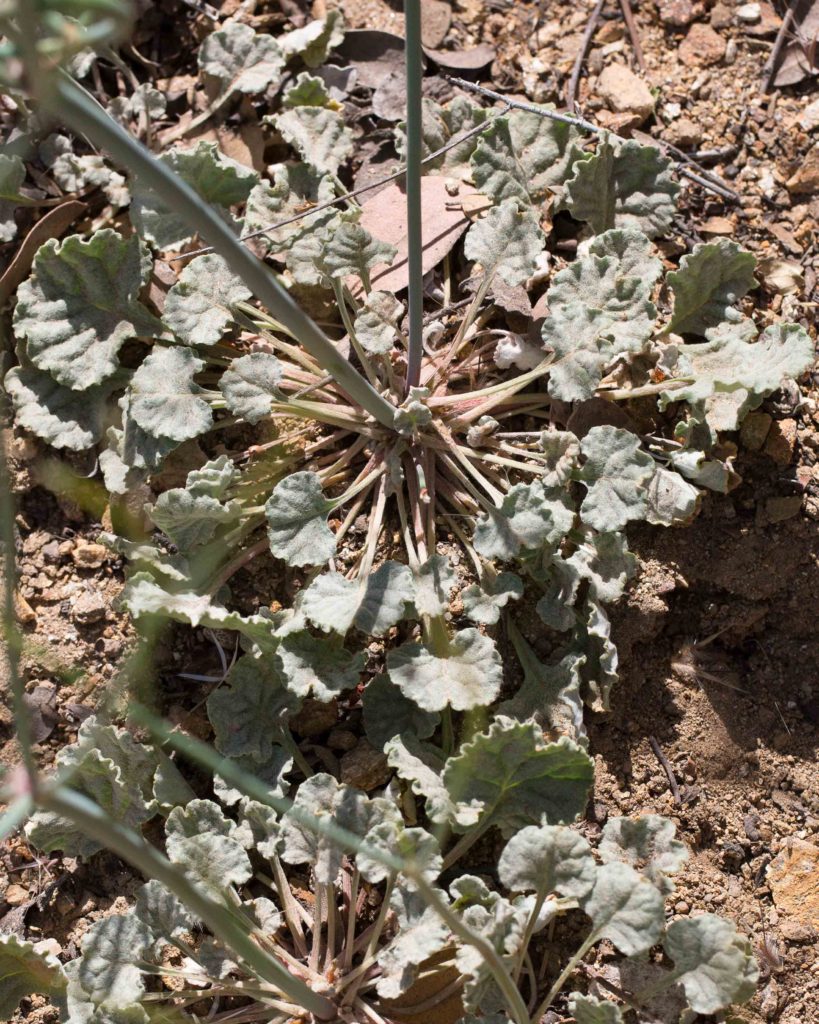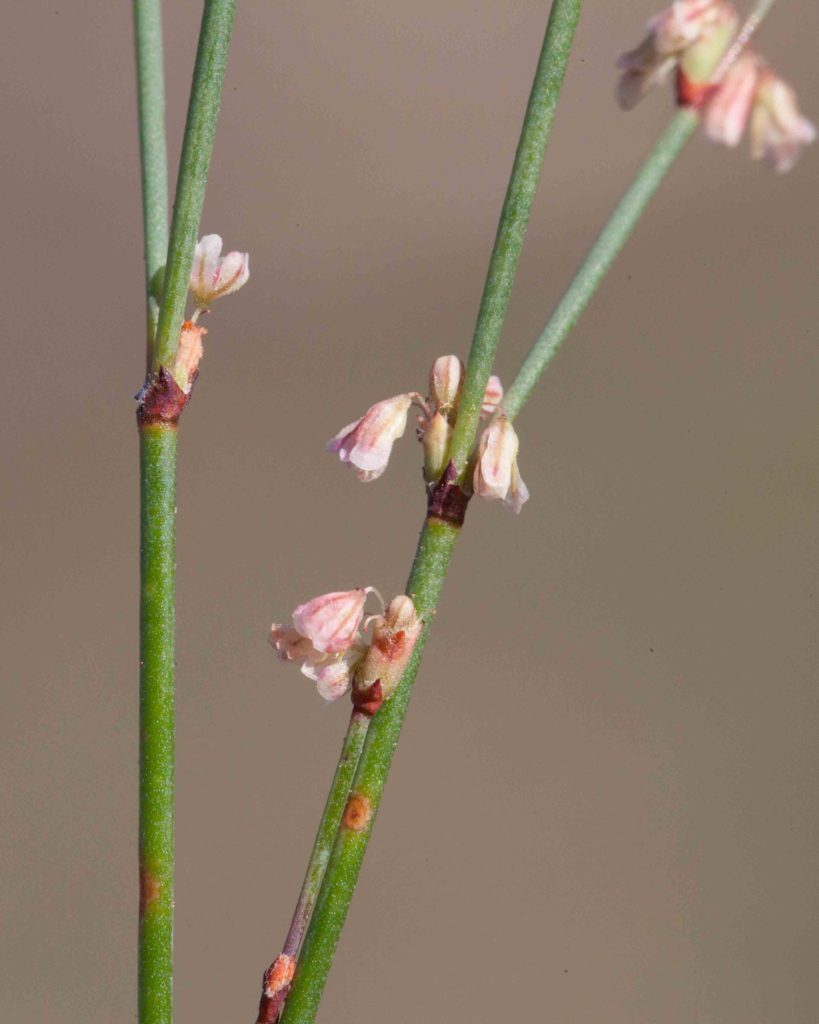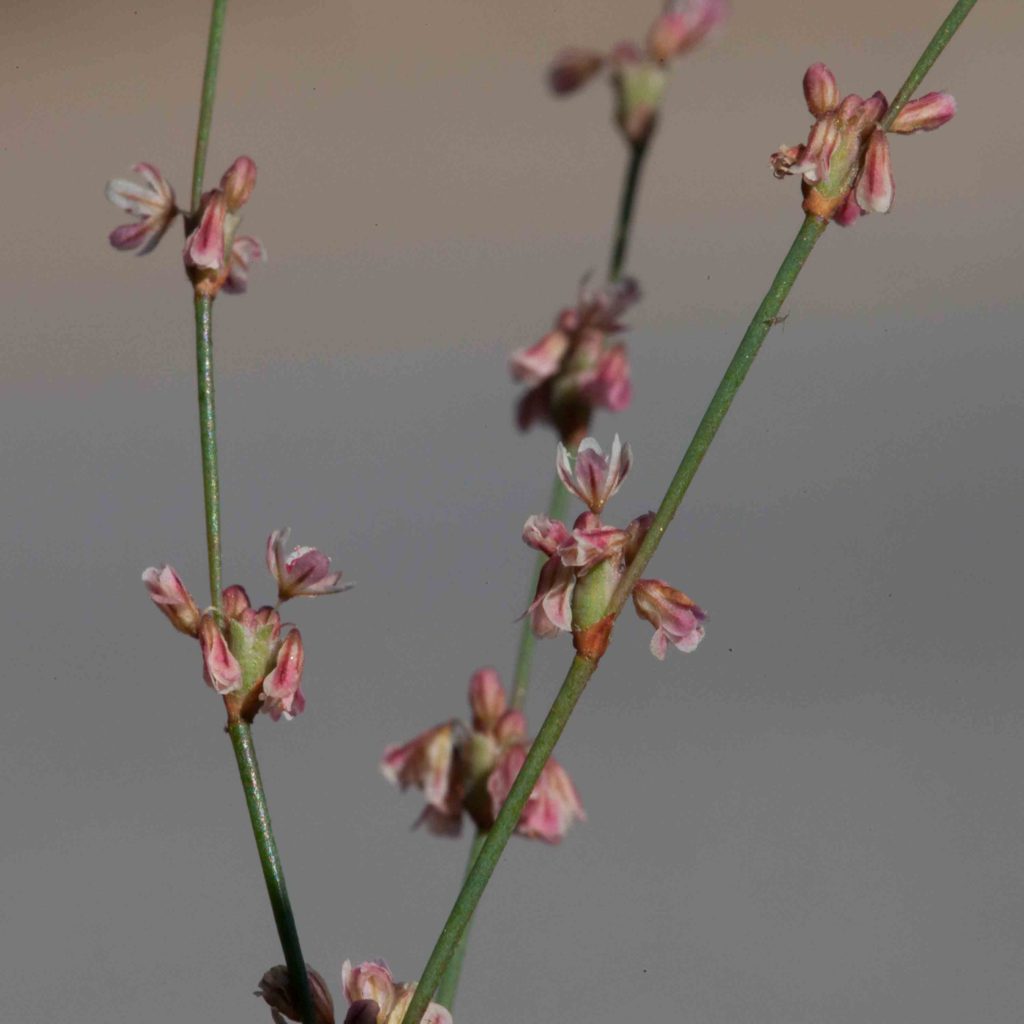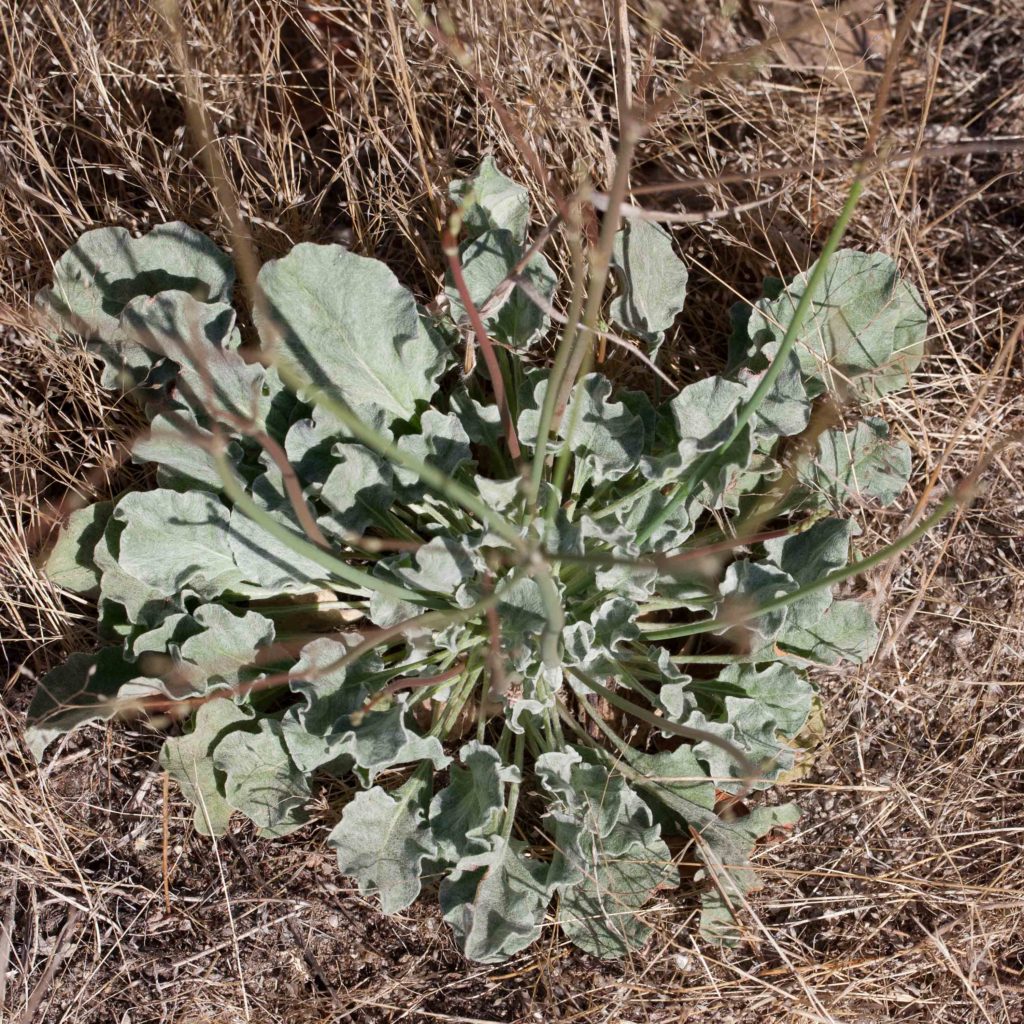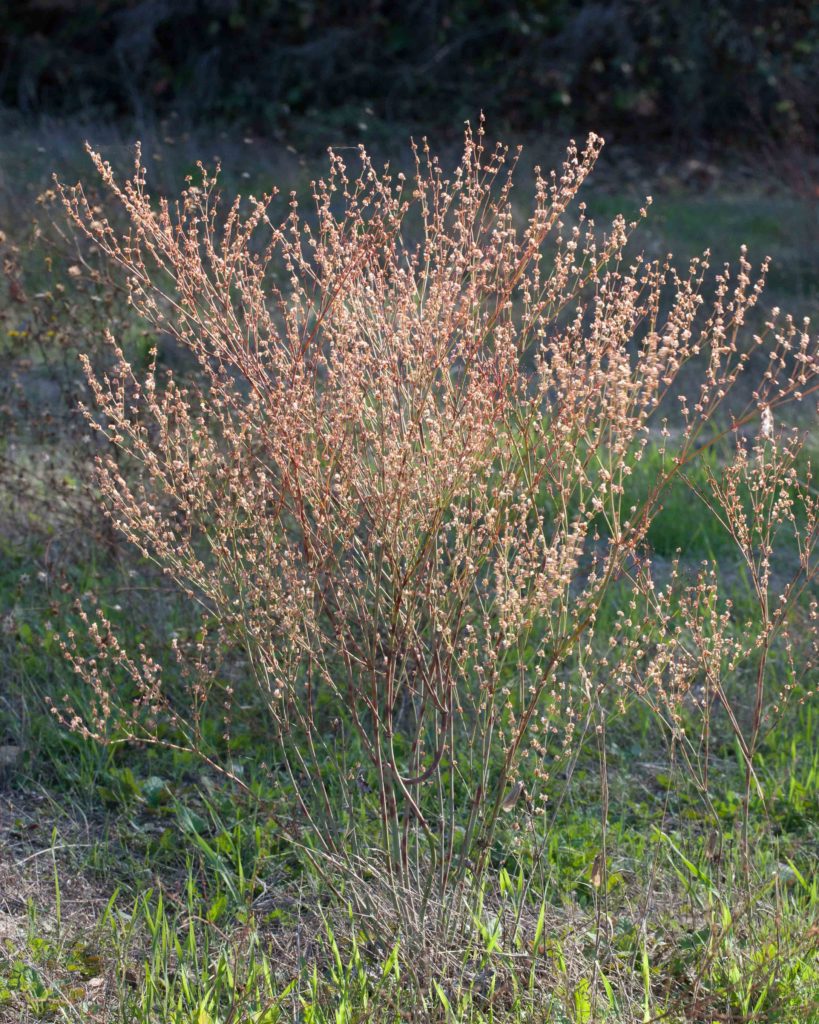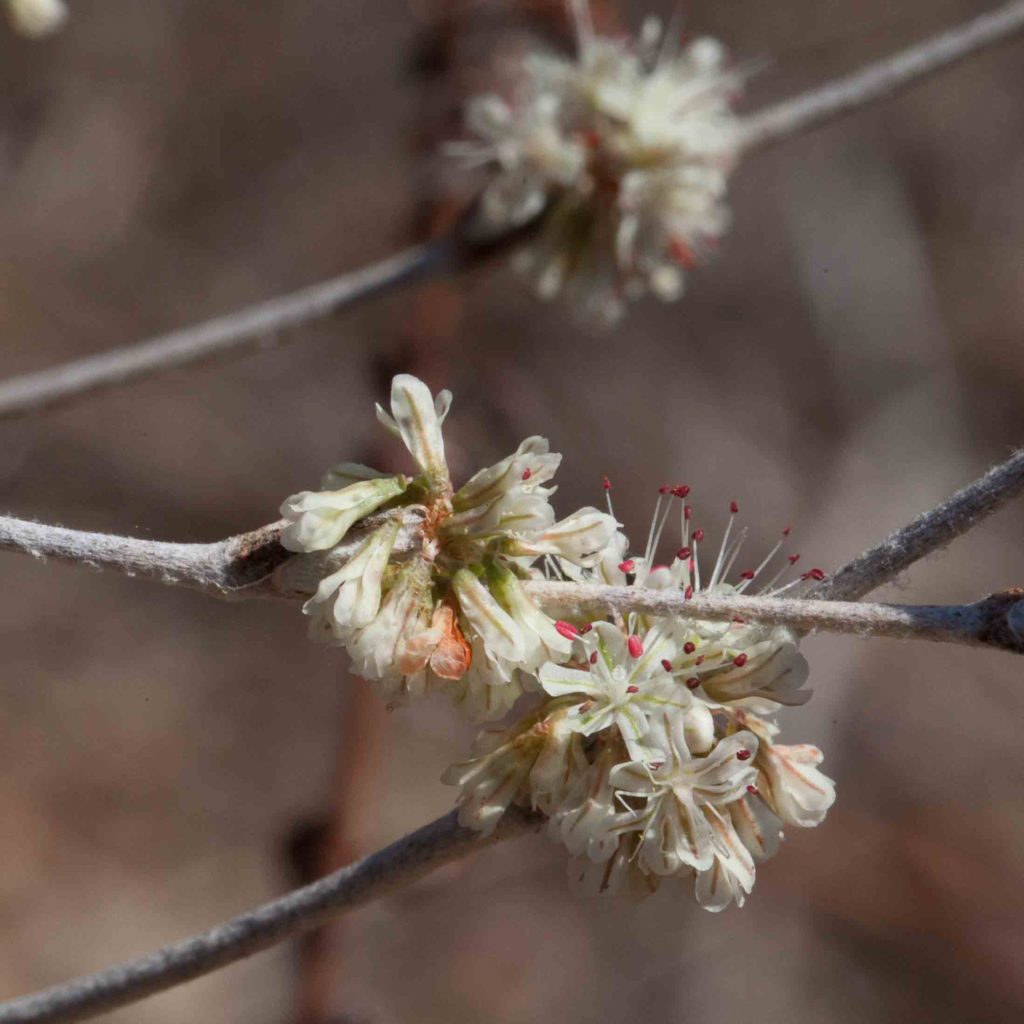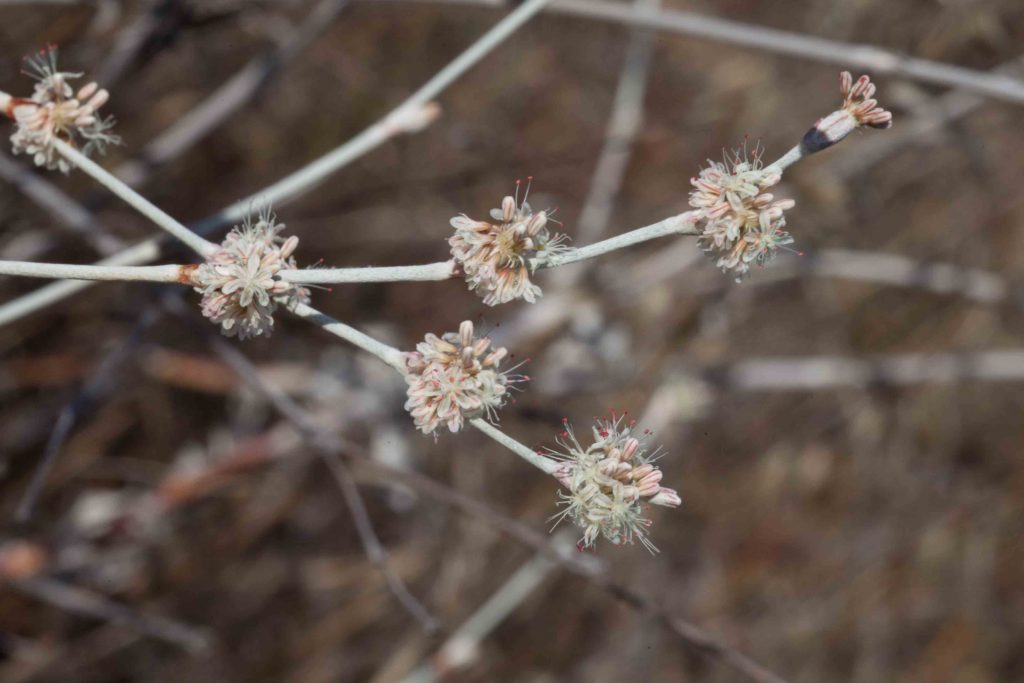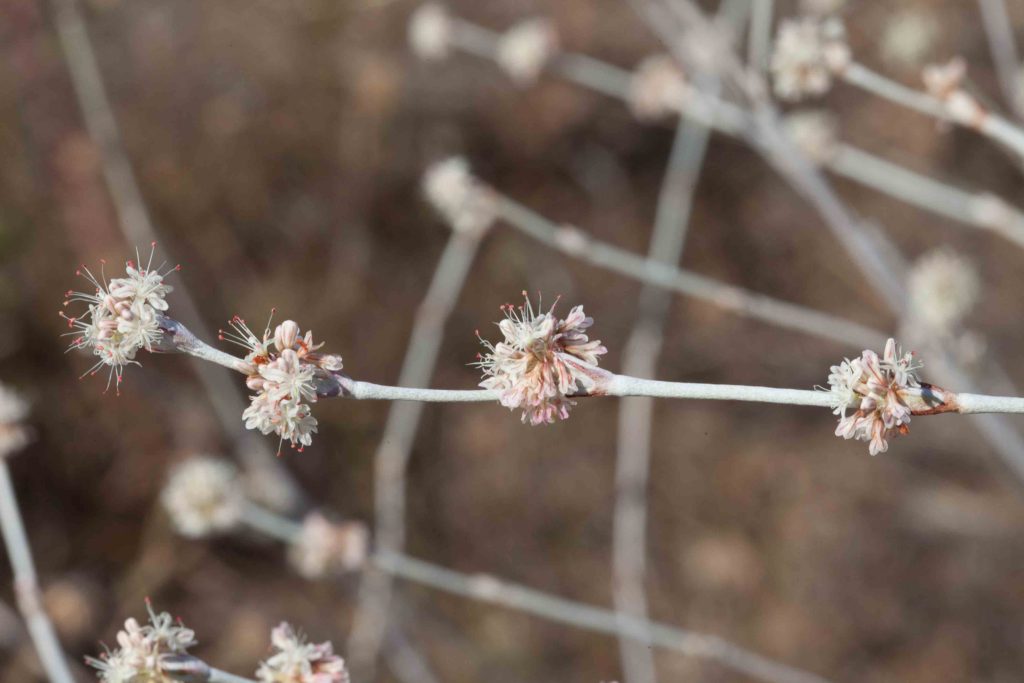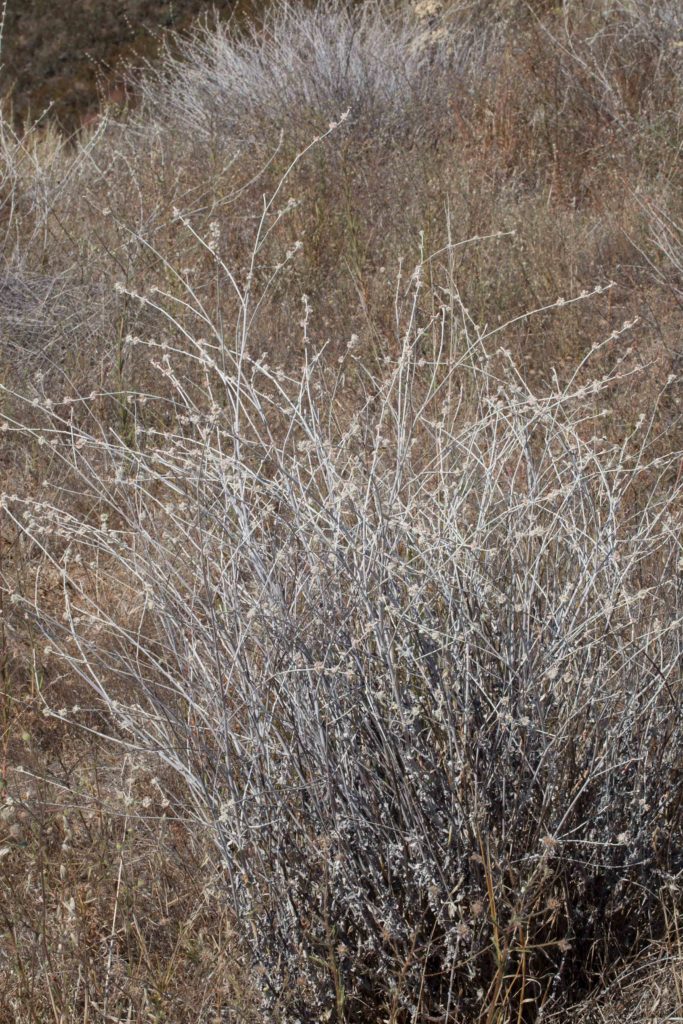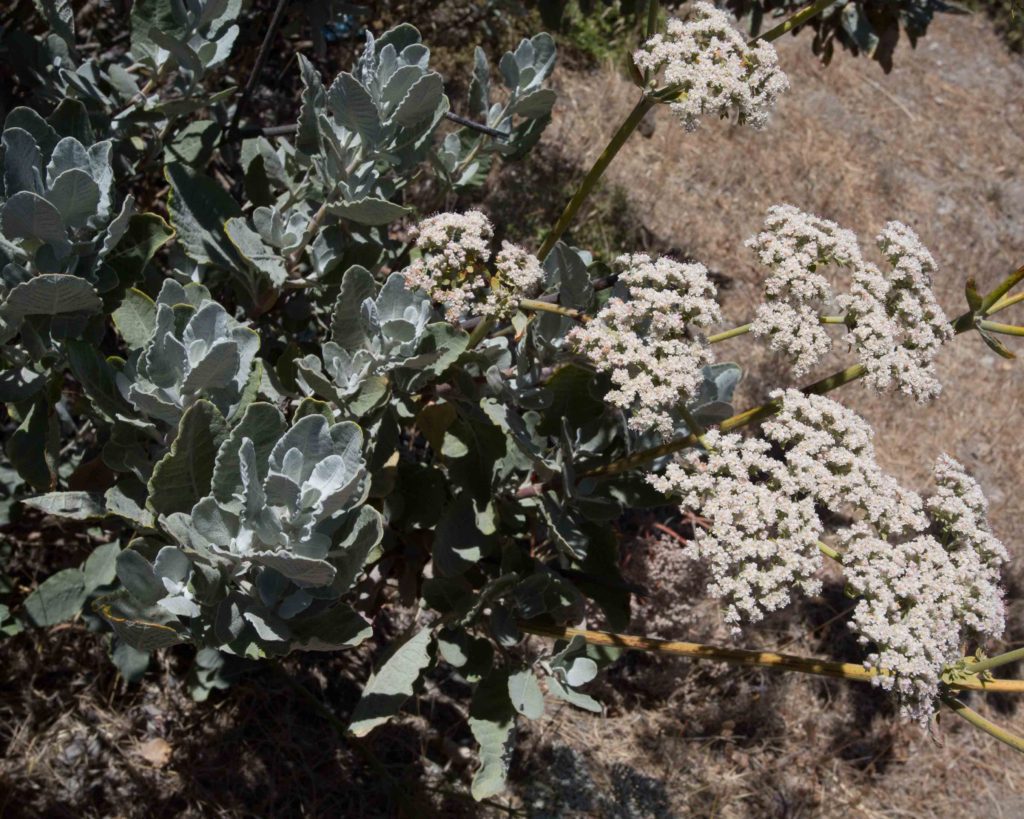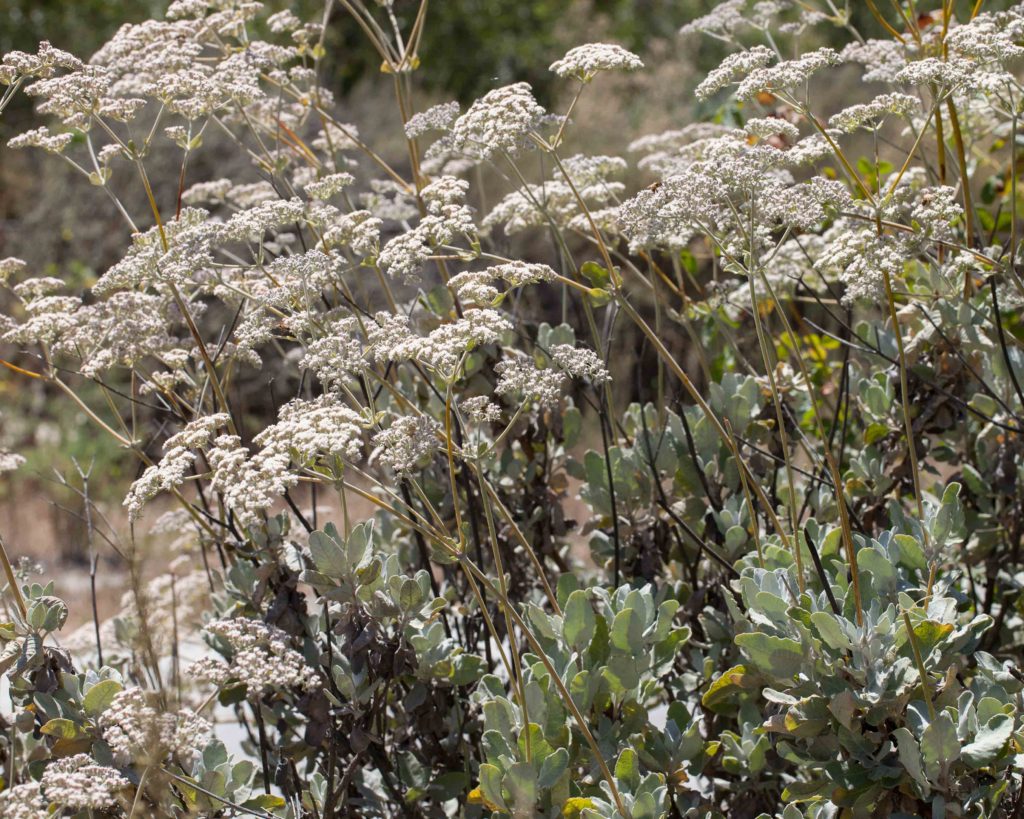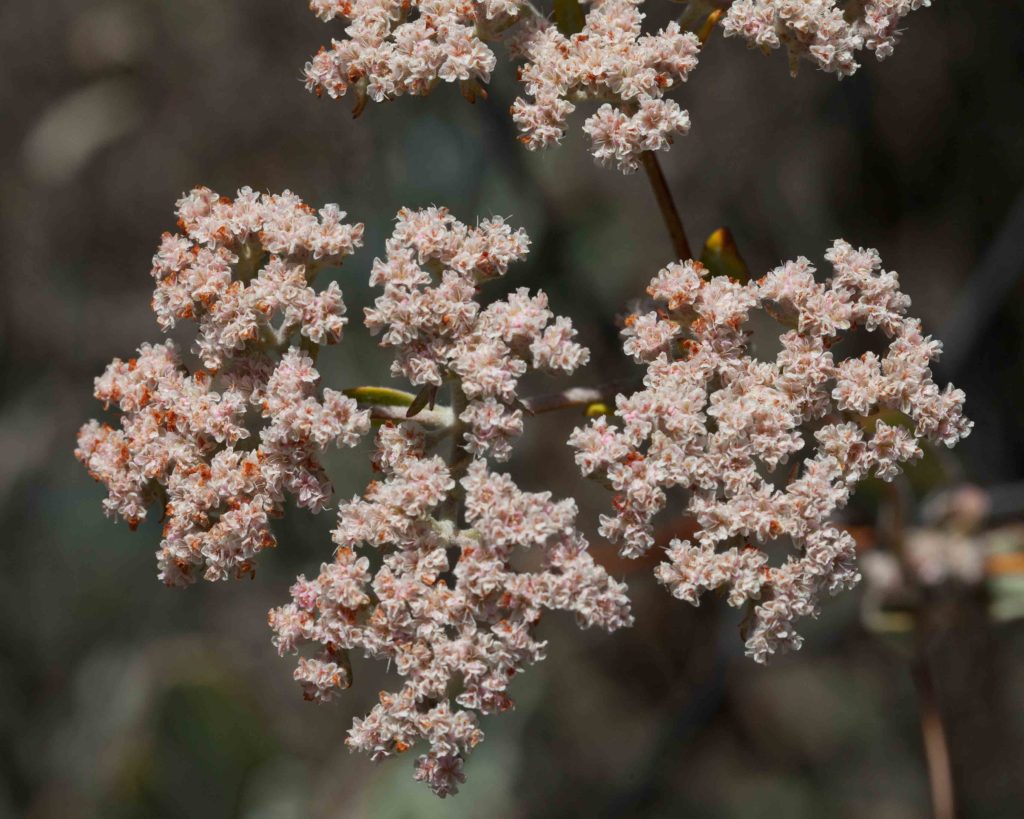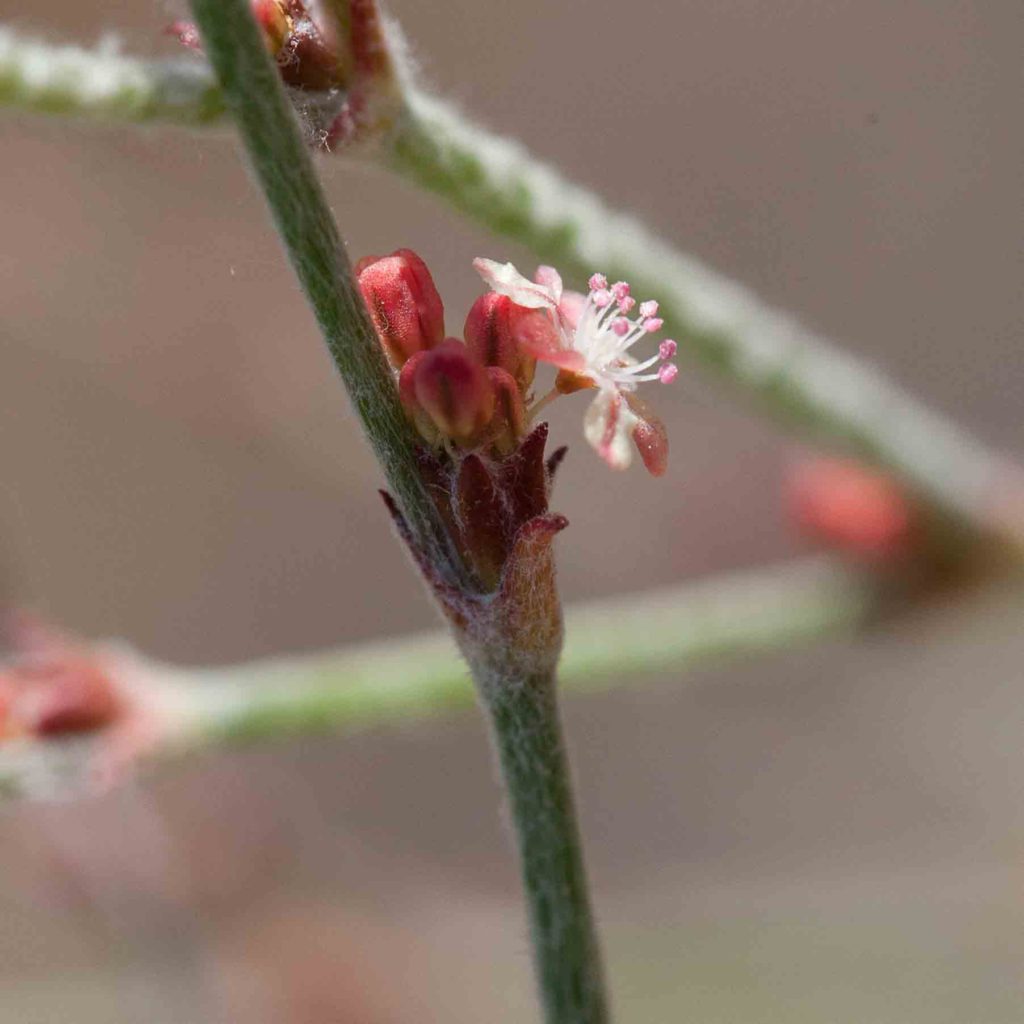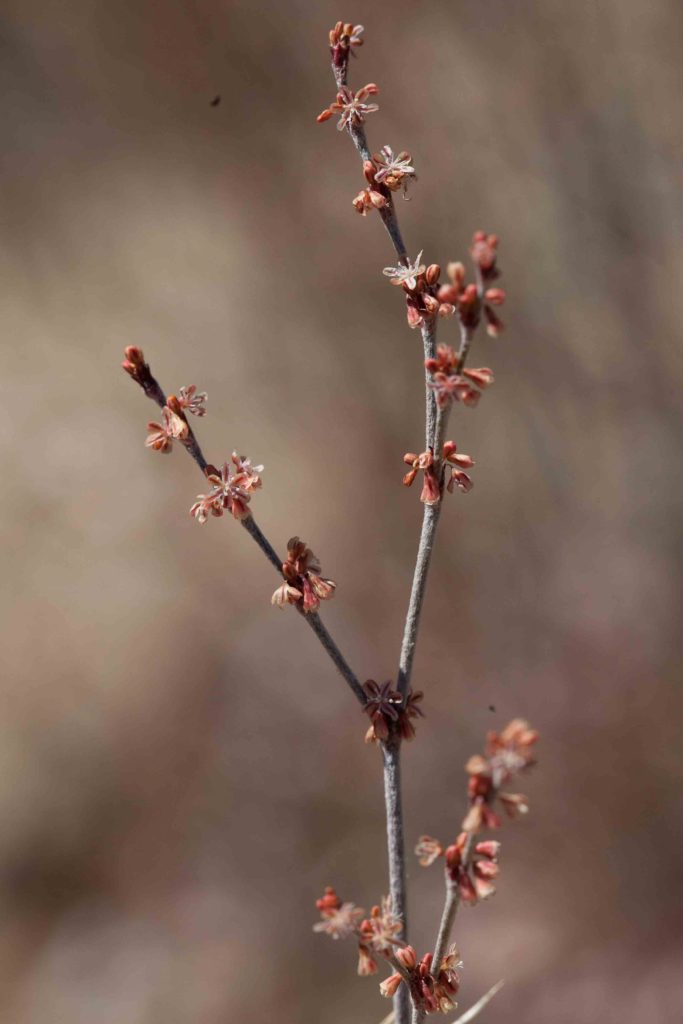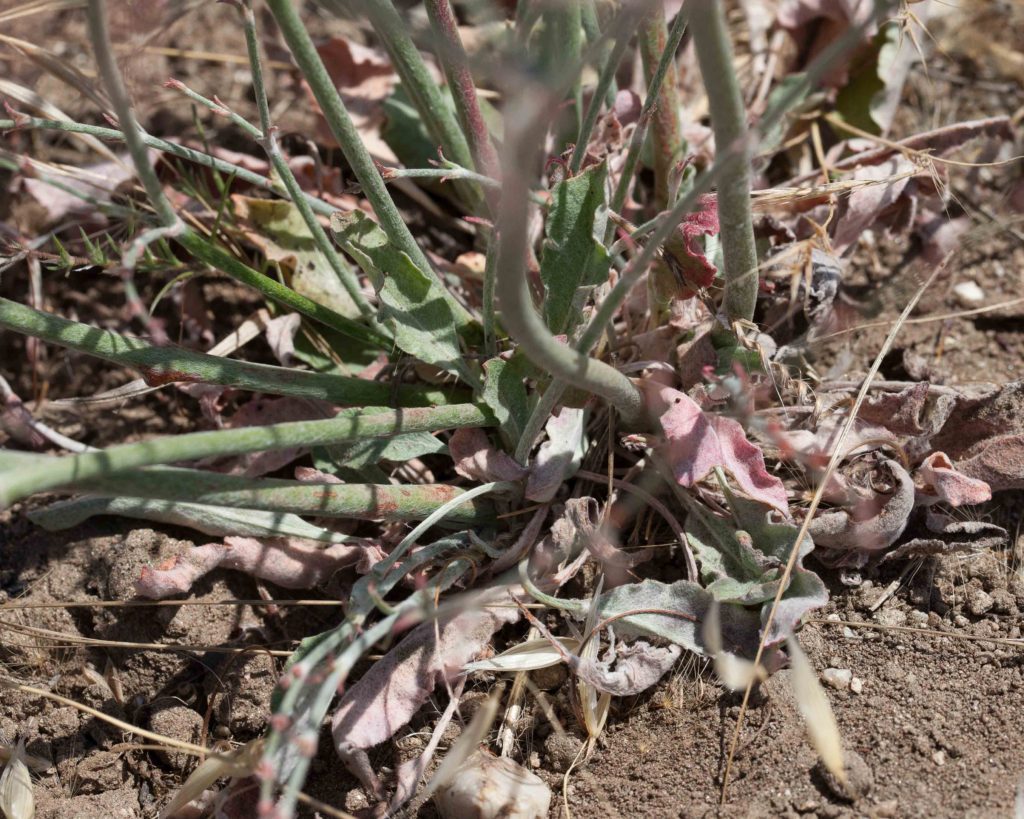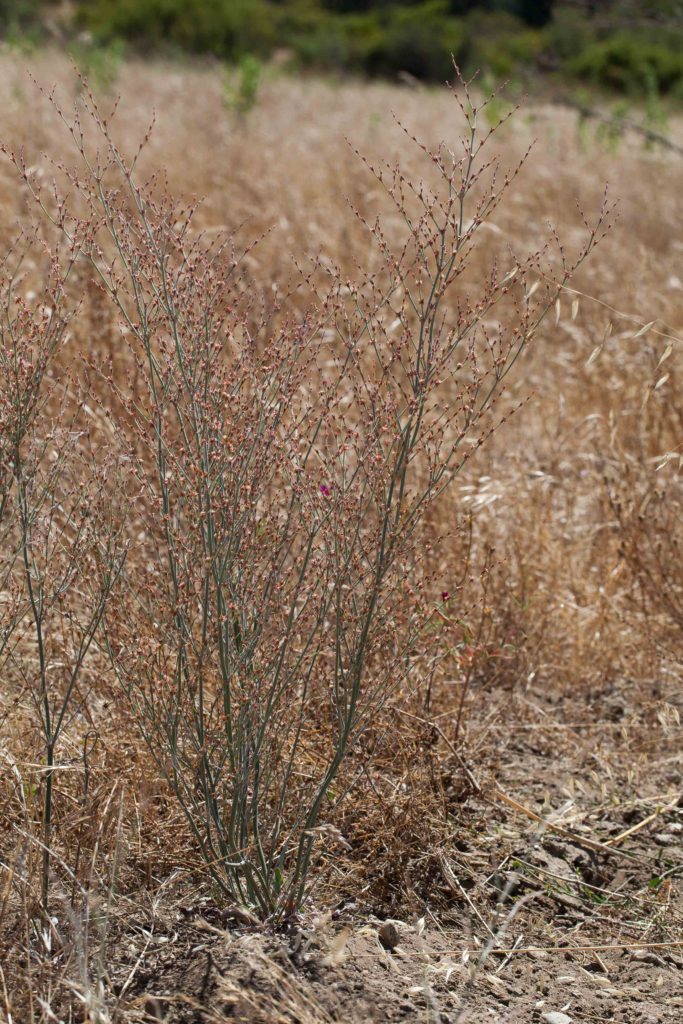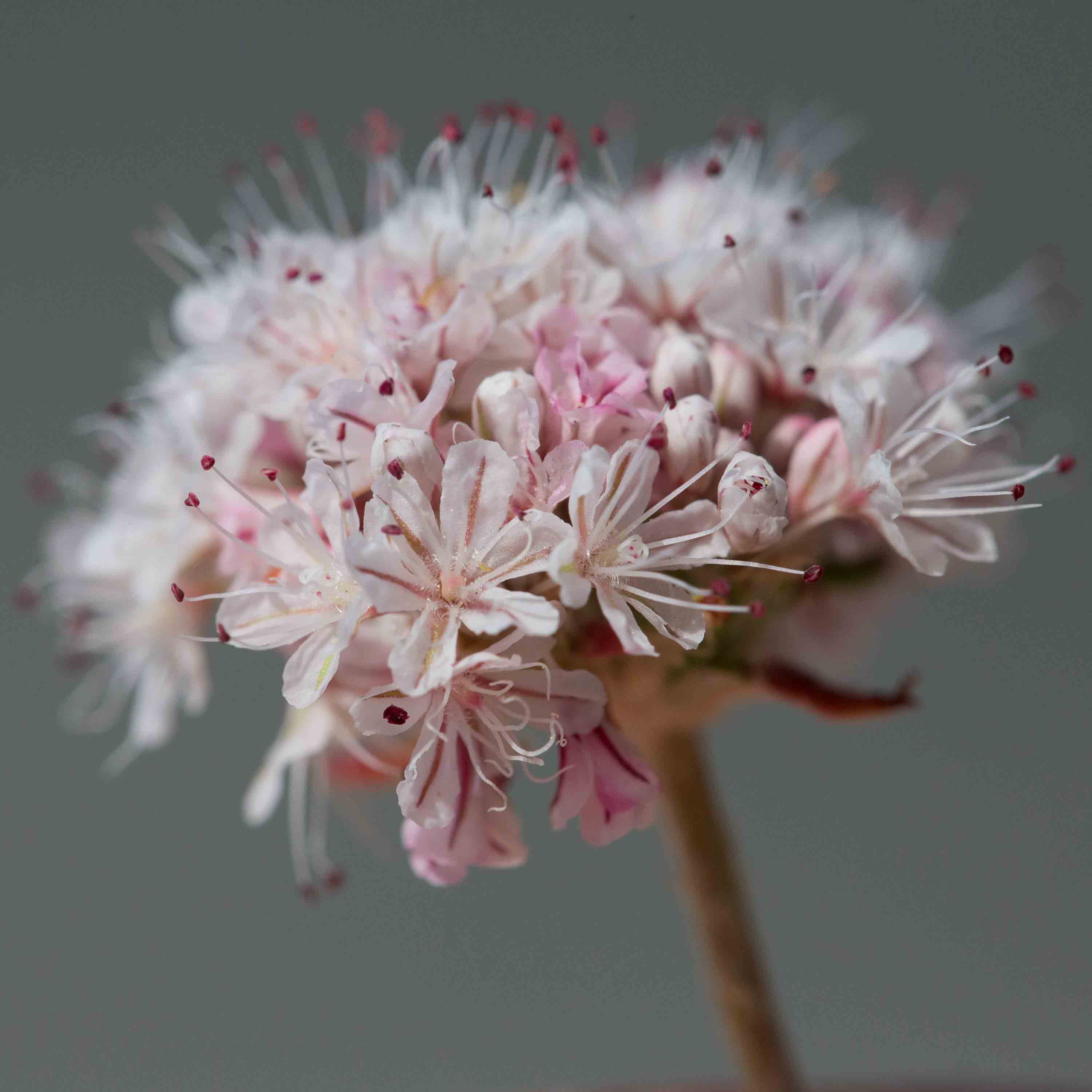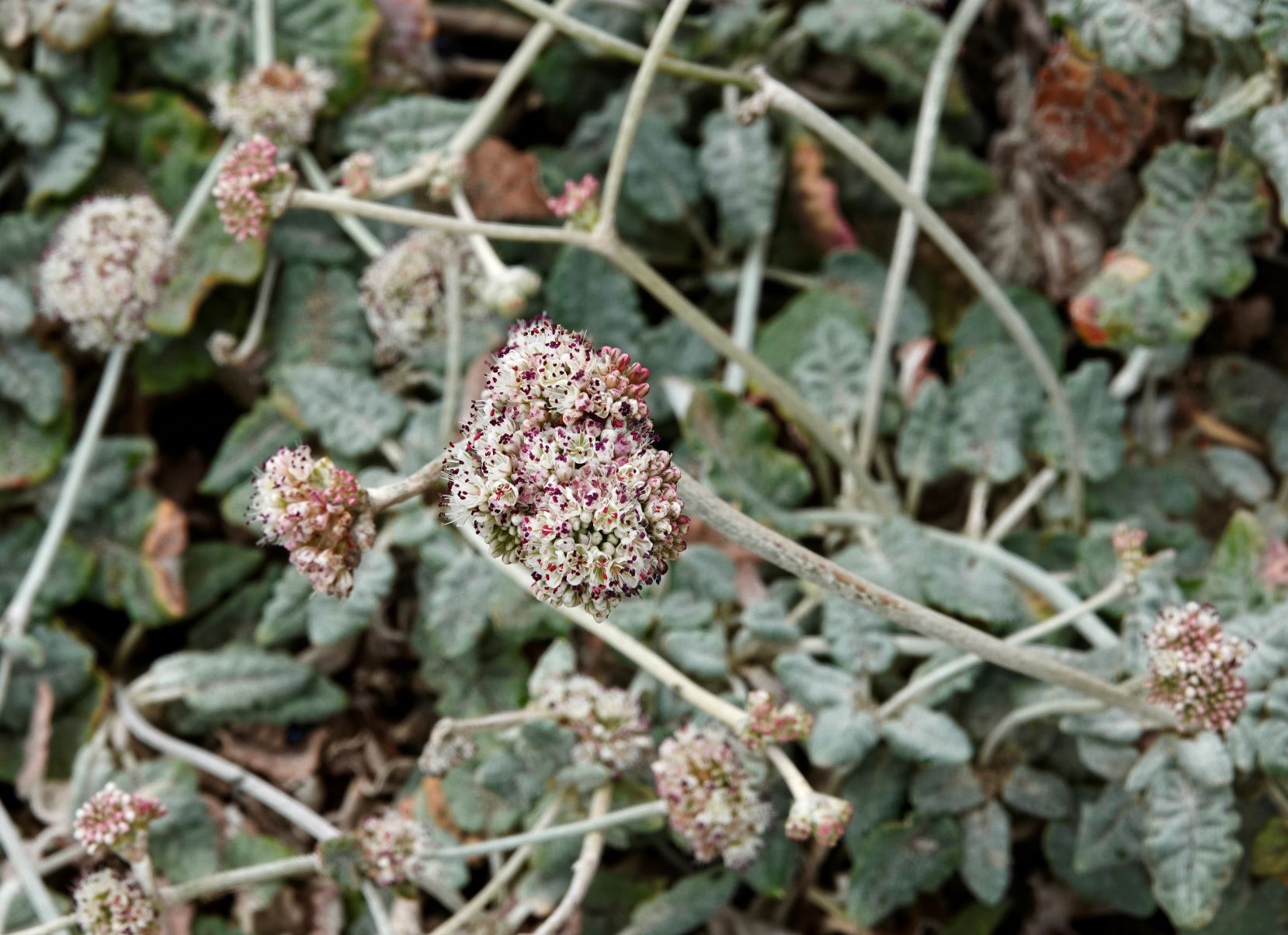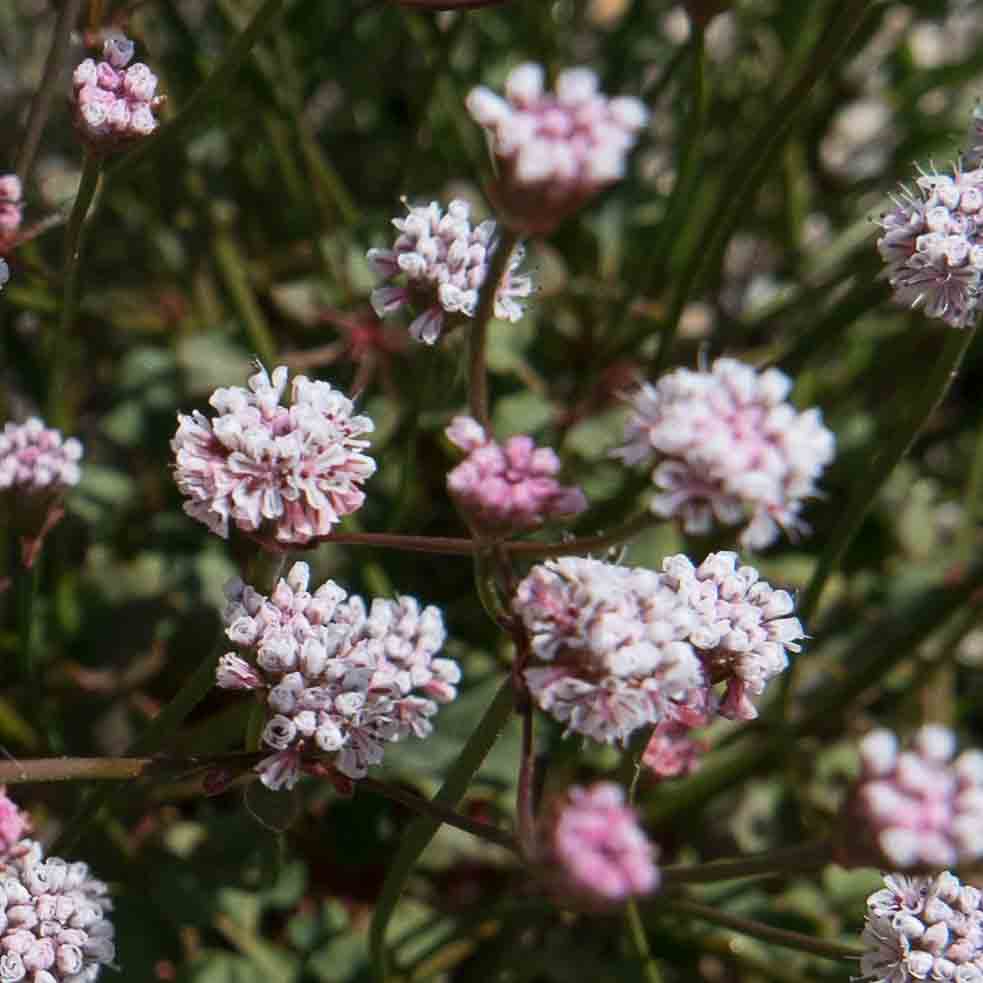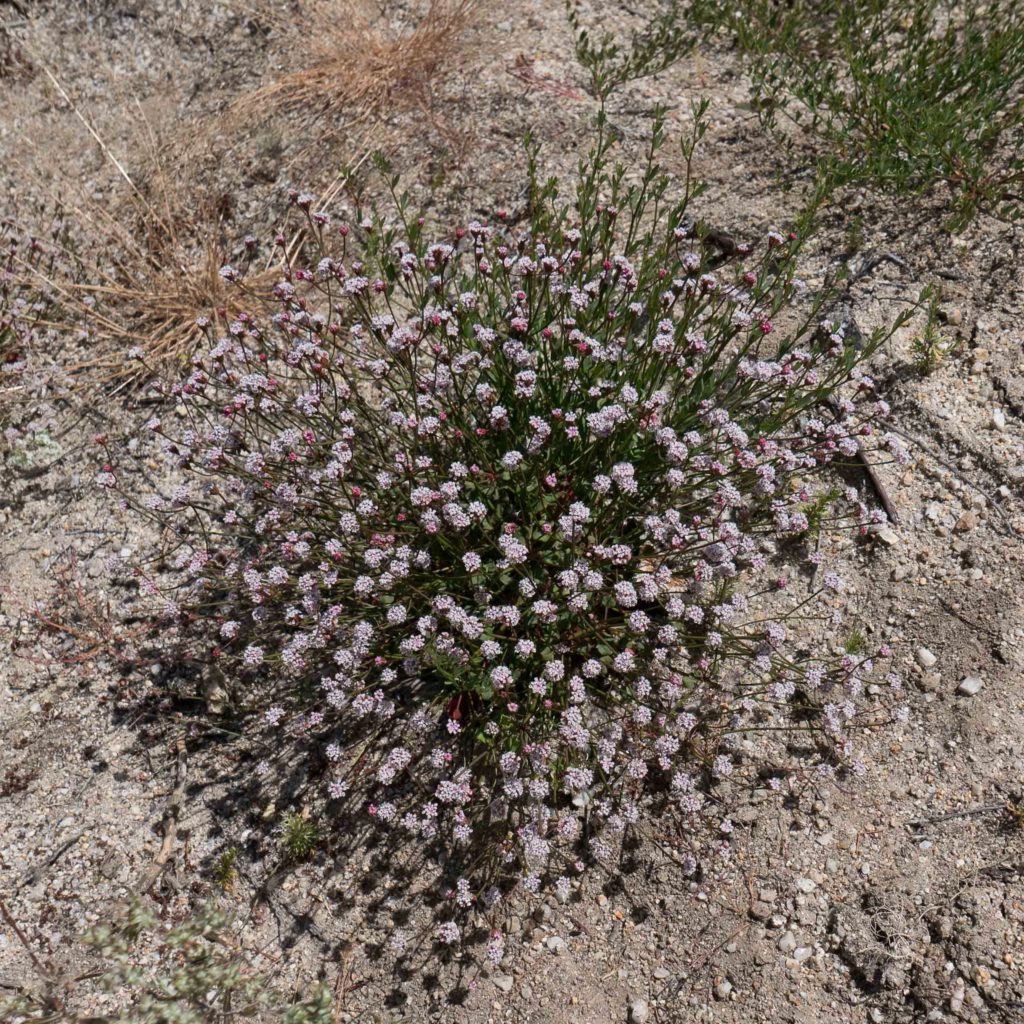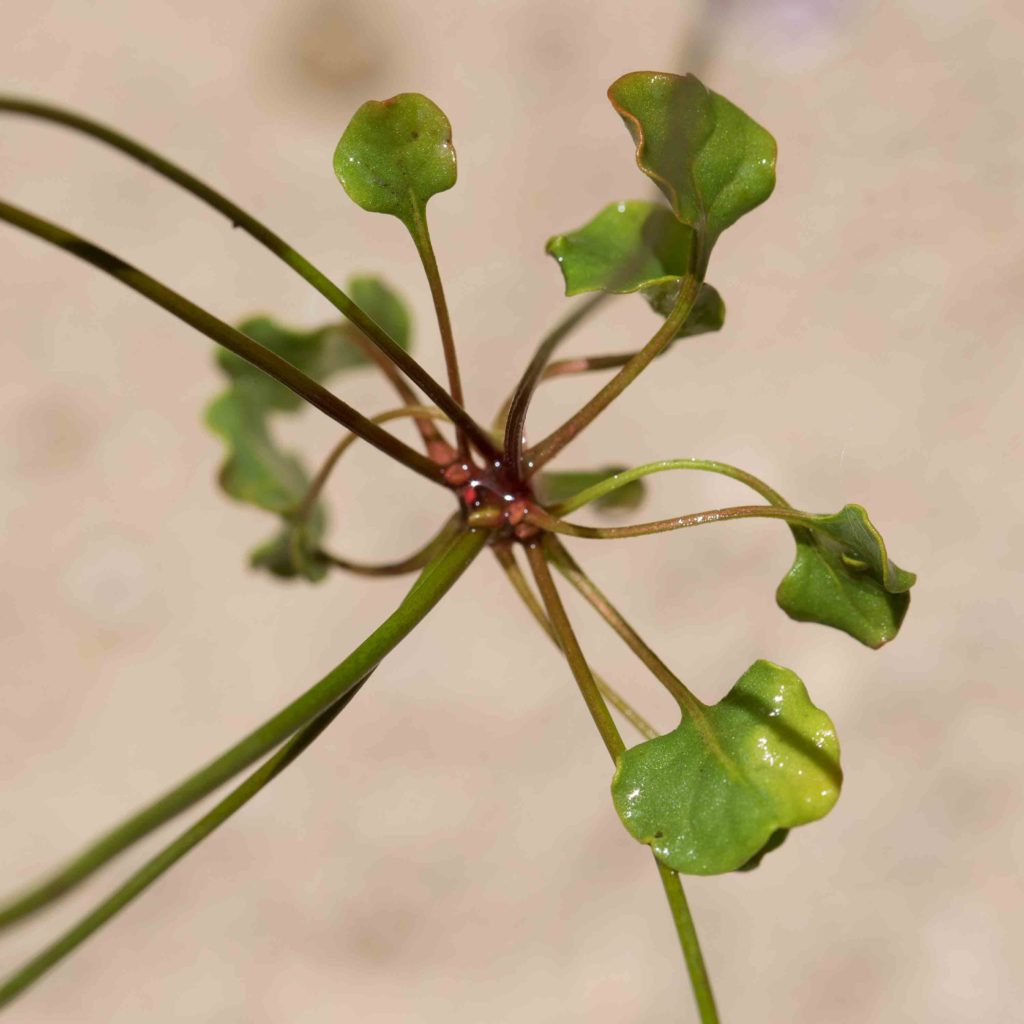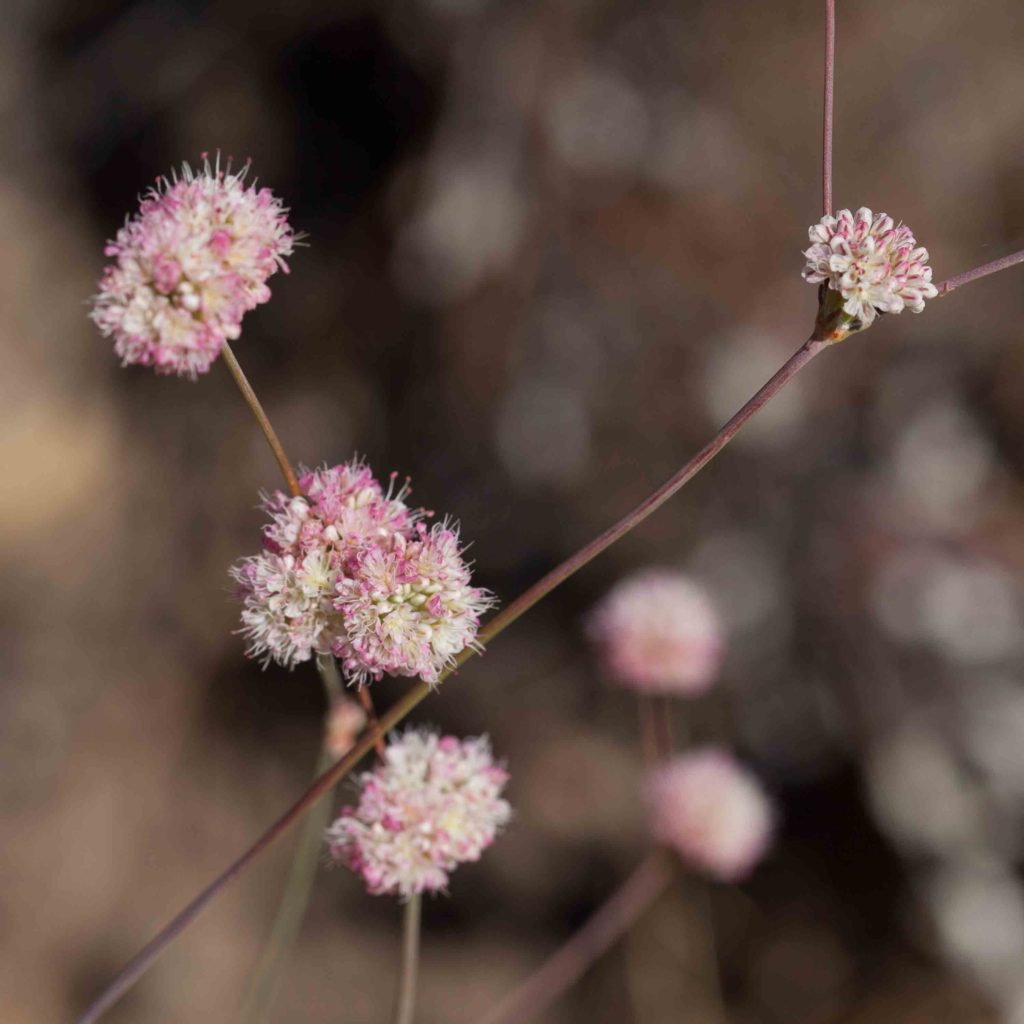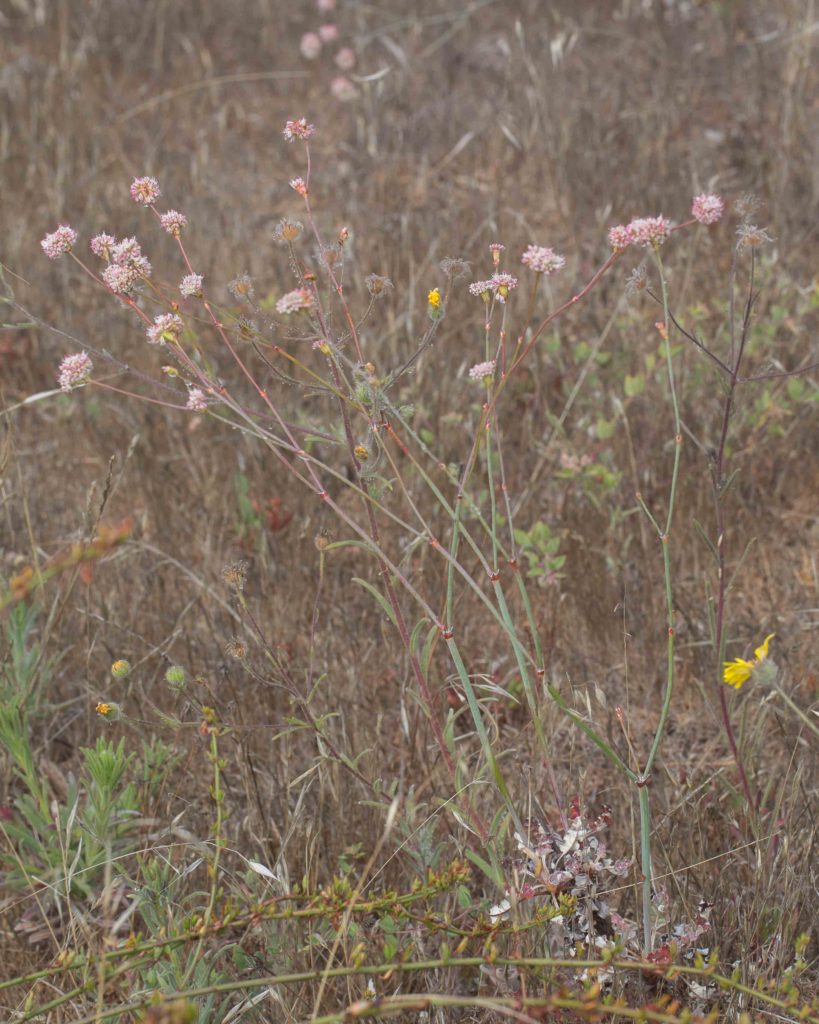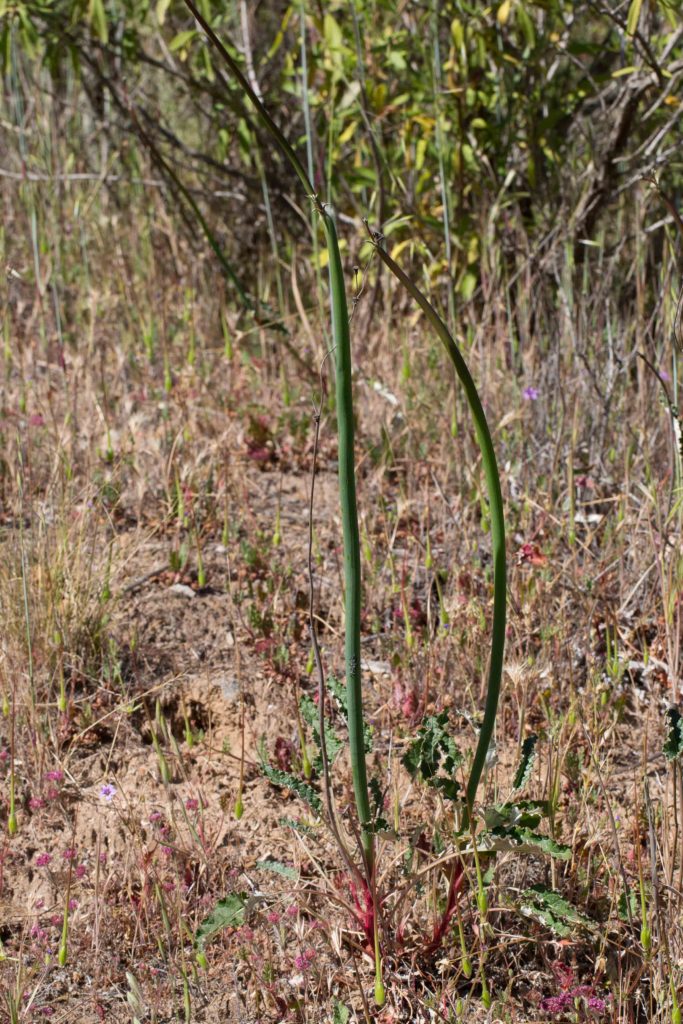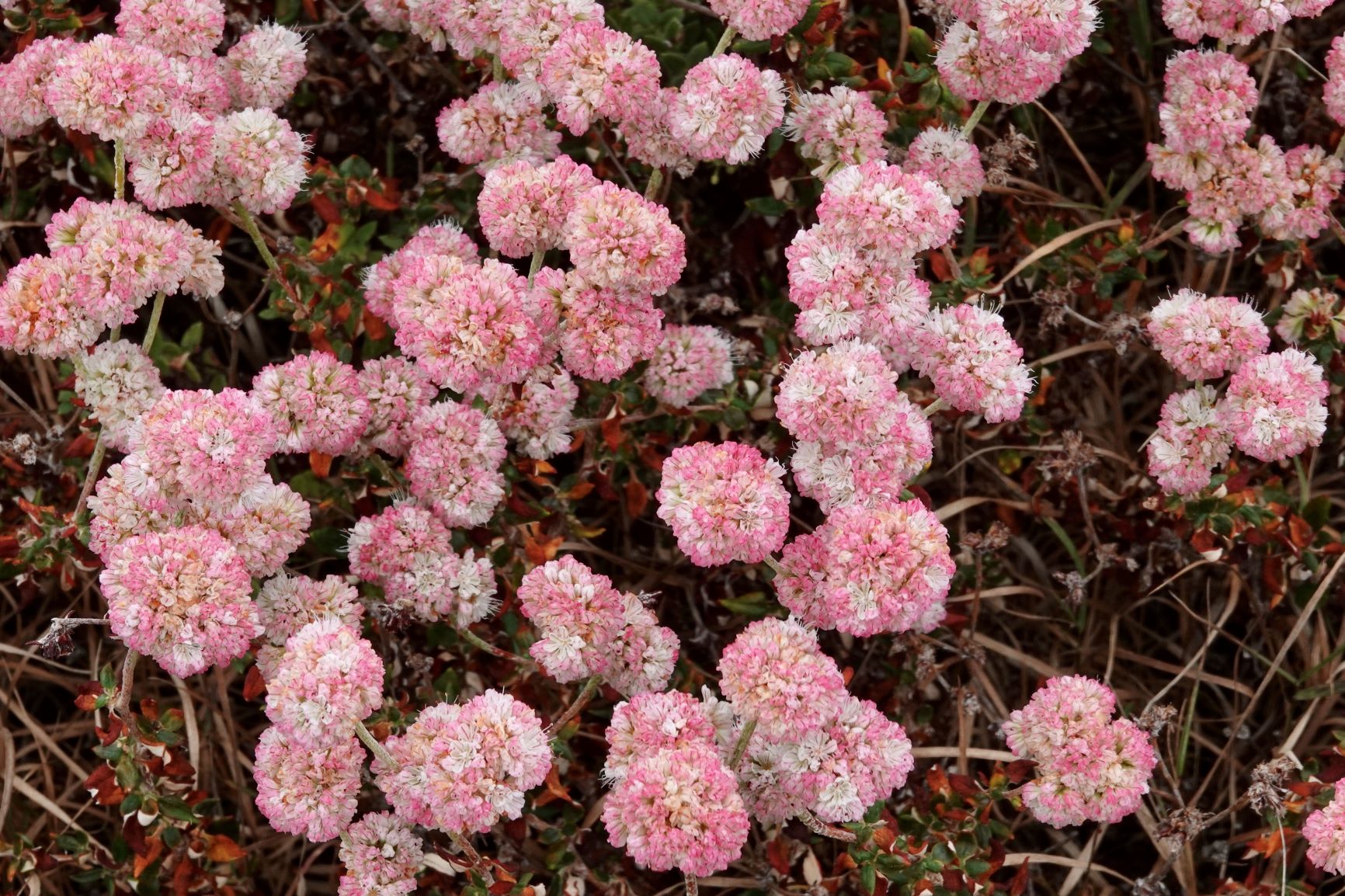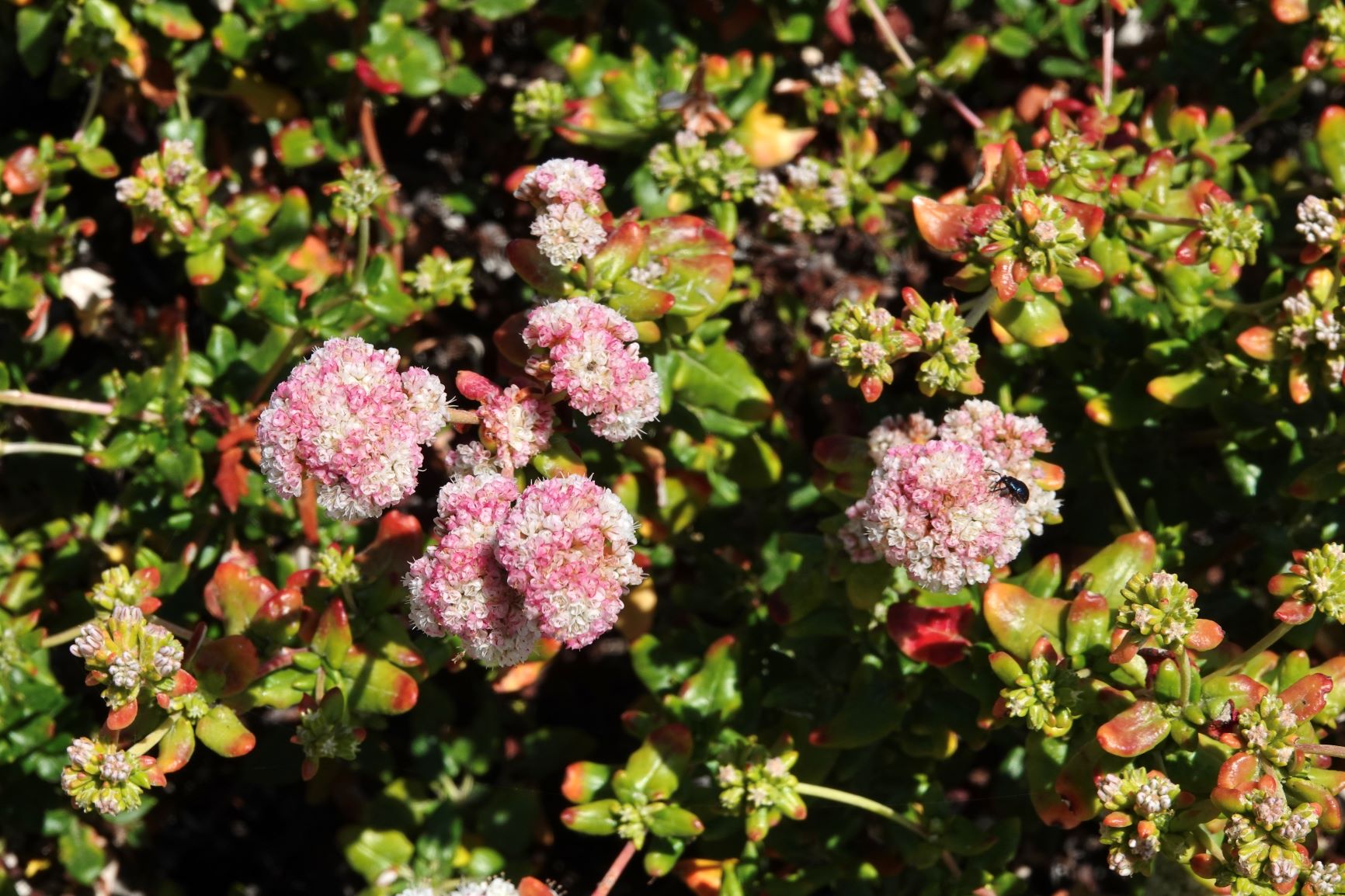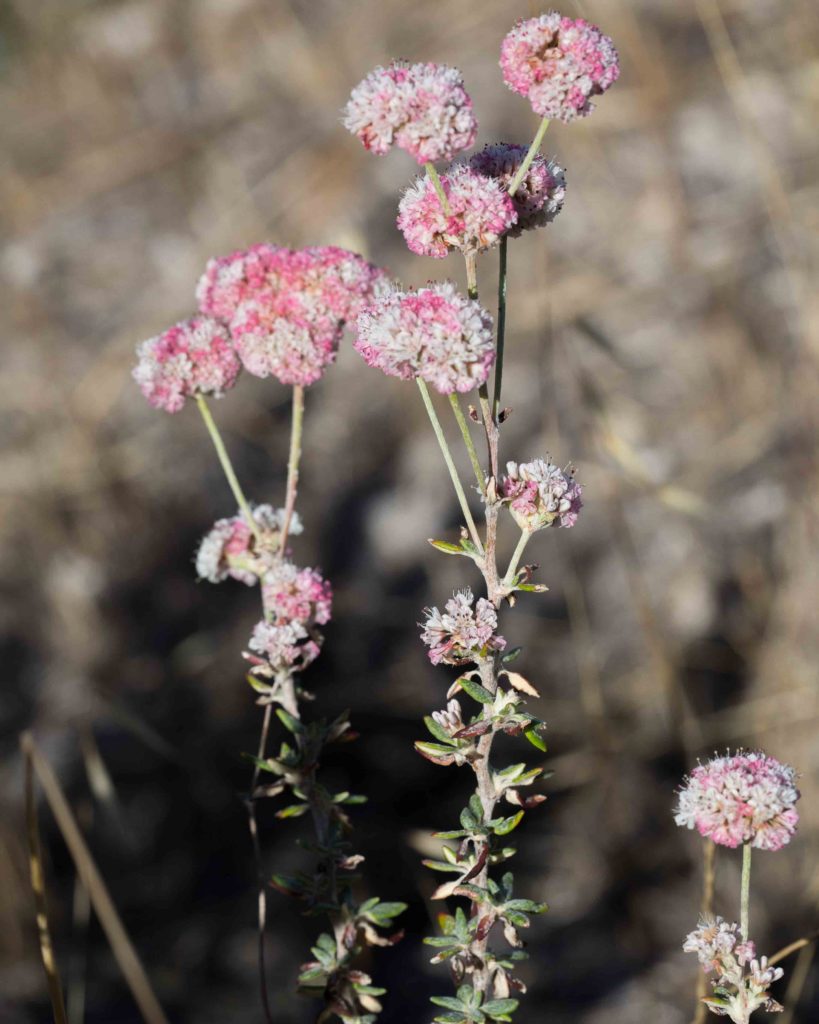Polygonaceae: Knotweed Family — Eriogonum (Buckwheat)
Flowers in this family do not have separate petals and sepals. For plants like this, the term “perianth” is used to describe the flower (i.e. the calyx and the corolla together) and “perianth parts” to describe the individual elements. Buckwheats are a very large and diverse group of plants, with almost 40 species found in Monterey, and about 120 in California. Not surprisingly, identification can prove challenging. Many of the flowers are quite similar, so you should pay attention to the leaves and growth habits instead. Beyond a certain point, a good botanical key is indispensable.
Davidson’s Wild Buckwheat – Eriogonum davidsonii
Blooms:
May–Sept
Plant Height:
10–50 cm
Flower Size:
Small cluster
Origin:
Native
Habitat:
Sandy places, generally above 900 m
Notes:
This is a fairly small plant, distinguished by the roundish shape of its small basal leaves, with their comparatively long petioles. Stems are glabrous, and involucres are cylindrical to top-shaped. The tiny flowers are found in the stem axils and nodes.
Elegant Wild Buckwheat – Eriogonum elegans
Blooms:
May–Nov
Plant Height:
10–50 cm
Flower Size:
Small cluster
Origin:
Native
Rare or endangered?
Yes – 4.3
Habitat:
Dry sandy flats and washes
Notes:
This is a fairly small plant, with many slender, branching stems. Flowers are tiny, each with a distinct pedicel. They form small clusters in stem axils, along the stem and at the stem tip. The stems are glabrous, and green or reddish. The involucre is small, 1–1.5 mm long.
Long-stemmed Wild Buckwheat – Eriogonum elongatum var. elongatum
Blooms:
July–Nov
Plant Height:
60–180 cm
Flower Size:
Small cluster
Origin:
Native
Habitat:
Sandy or clay soils
Notes:
This is a dense, somewhat tangled shrub, grayish-white in appearance and much branched from the base. Flowers are creamy white with a pink tinge, located laterally in small spherical bundles at stem nodes. The stems are densely tomentose — hence their whitish color.
Leafy California Wild Buckwheat – Eriogonum fasciculatum var. foliolosum
Blooms:
July–Nov
Plant Height:
60–180 cm
Flower Size:
Small cluster
Origin:
Native
Habitat:
Dry sunny gravelly areas
Notes:
Common, often planted along roadsides. This is easily recognized by its hairy flowers and clustered (fascicled) linear to oblanceolate leaves. Flowers are in clusters at stem tips and nodes. Leaves are small (6–12 mm long and < 4 mm wide), green to sparsely pubescent above, and densely tomentose below. Leaf margins are strongly rolled under. This may be confused with some forms of Seacliff Wild / Dune Buckwheat (Eriogonum parvifolium, see below).
.
Saint Catherine’s Lace – Eriogonum giganteum var. giganteum
Blooms:
June–Sept
Plant Height:
50–350 cm
Flower Size:
Large cluster
Origin:
Native
Habitat:
Widely cultivated and introduced, freeway medians, roadsides
Notes:
This large buckwheat has big flowerheads, with an umbel-like appearance. It is most easily recognized by its thick felty leaves. The flowers are white to rose, and more loosely clustered than other buckwheats. It is native to southern California, but has been widely planted, and can be invasive.
Slender Woolly Wild Buckwheat – Eriogonum gracile var. gracile
Blooms:
All year
Plant Height:
15–50 cm
Flower Size:
Small cluster
Origin:
Native
Habitat:
Dry sandy or gravelly flats or slopes
Notes:
Like Elegant Wild Buckwheat (Eriogonum elegans, see above), this is a smallish plant with many slender, branching stems. The flowers are tiny, each with a distinct pedicel, and borne in small clusters in stem axils, along the stem and at the tip. It is distinguished by its tomentose stems and its larger (2–5 mm long) involucre. The basal leaves are mostly withered by blooming time.
Coast / Seaside Wild Buckwheat – Eriogonum latifolium
Blooms:
All year
Plant Height:
20–70 cm
Flower Size:
Small cluster
Origin:
Native
Habitat:
Cliffs and sandy places along coast
Notes:
Very common in immediate coastal areas, this is variable in its appearance, depending on habitat and exposure. It is often low growing and spreading, but the stems may be erect and up to 70 cm tall. Flowers range from white to pink, in characteristic buckwheat spherical clusters, growing in axils and at the stem tips. Leaves are generally tomentose, up to 5 cm long and 4 cm wide, pale grayish-green in color. This plant is one of the favorite food sources for the endangered Smith’s Blue Butterfly. Photo #2 by CJH.
Pinnacles Buckwheat – Eriogonum nortonii
Blooms:
May–Aug
Plant Height:
5–20 cm
Flower Size:
Small cluster
Origin:
Native
Rare or endangered?
Yes – 1b.3
Habitat:
Sandy to gravelly slopes, 300–1200 m
Notes:
This is a diminutive and rare buckwheat. It is found in northern Monterey County, the Pinnacles and Fremont Peak. In normal conditions, it tends to be very small and scruffy. But in good conditions or following a fire, it produces a much lusher, denser plant, though still small. Leaves are 5–15 mm across, roundish and tomentose on the lower surface. The flowers are likewise very small, in spherical clusters, generally at the stem tips.
Ear-shaped Wild Buckwheat – Eriogonum nudum var. auriculatum
Blooms:
May–Oct
Plant Height:
50–150 cm
Flower Size:
Small cluster
Origin:
Native
Habitat:
Sandy, gravelly or clay soils
Notes:
This common buckwheat has tall, leafless stems, each topped with rounded clusters of white, pale pink or yellow flowers. Leaves are basal, or sheathing up the stem, and noticeably wavy. Stems are usually glabrous (hence the nudum in the scientific name), but can be hairy or even tomentose. They are hollow, and can be slightly inflated, the bulging easily visible to the naked eye.
Seacliff Wild / Dune Buckwheat – Eriogonum parvifolium
Blooms:
All year
Plant Height:
30–100 cm
Flower Size:
Small cluster
Origin:
Native
Habitat:
Sandy soils, coastal and near coastal
Notes:
This common shrub comes in two rather different forms. By the immediate coast it has smallish, fleshy leaves, glabrous above and tomentose below. Away from the coast, leaves are not fleshy, and are often slightly woolly above. Leaves are clustered, lanceolate to round. Flowers (except for the hairy base of the filaments) are glabrous, white to pink, often in the same cluster. The inland form may be mistaken for Leafy California Buckwheat (Eriogonum fasciculatum, see above), except for the different leaf shape (lanceolate rather than linear to oblanceolate) and the glabrous flowers. Photos #1, 2 and 4 by CJH.

